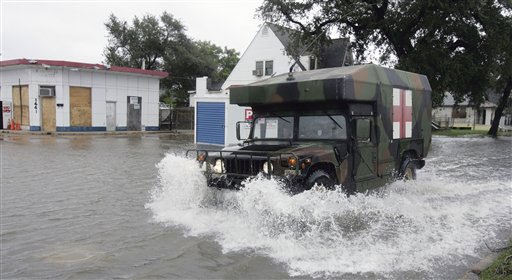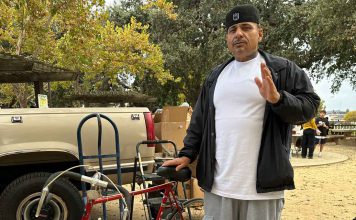Anxious evacuees across the country clamored to come home
Tuesday after their city was largely spared by Hurricane Gustav,
but Mayor Ray Nagin warned they may have to wait in shelters and
motels a few days longer.
Anxious evacuees across the country clamored to come home Tuesday after their city was largely spared by Hurricane Gustav, but Mayor Ray Nagin warned they may have to wait in shelters and motels a few days longer.
The city’s improved levee system helped avert a disaster like Hurricane Katrina, which flooded most of the city, and officials got an assist from a disorganized and weakened Gustav, which came ashore about 72 miles southwest of the city Monday morning. Eight deaths were attributed to the storm in the U.S. after it killed at least 94 people across the Caribbean.
But New Orleans was still a city that took a glancing blow from a hurricane: A mandatory evacuation order and curfew remained in effect. Electric crews started work on restoring power to the nearly 80,000 homes and businesses in New Orleans – and more than 1 million in the region – that remained without power after the storm damaged transmission lines that snapped like rubber bands in the wind.
“We have a massive caravan of crews coming to the city and they should be here this morning to fix the rest of the power outages,” Nagin said on CBS “Early Show.”
The city’s sewer system was damaged, and hospitals were working with skeleton crews on backup power. Drinking water continued to flow in the city and the pumps that keep it dry never shut down – two critical service failings that contributed to Katrina’s toll. The FAA said the city’s airport was expected to reopen at 7 p.m.
Gustav was downgraded to a tropical depression early Tuesday, and mandatory evacuation orders were lifted for three Southeast Texas counties. The storm’s maximum sustained winds decreased to near 35 mph as it puttered toward northern Louisiana and east Texas. Up to 8 inches of rain was expected and flood warnings were posted.
Nagin cautioned that Tuesday would be too early for residents to return to New Orleans, but their homecoming was “only days away, not weeks.” He apologized to the Republicans, which put the pagentry of their convention on hold to wait for Gustav to move through the Gulf Coast.
“You know, I think Gustav rained on their parade, on their little party,” said Nagin, a Democrat, who cut his own trip short to his party’s convention to prepare for the storm. “And hopefully they can rekindle. We’d love to host them in New Orleans next week, and they can come down and we can show them how to really do it right.”
Crews would comb the city Tuesday to fully review the damage, Nagin said, with the goal of having residents return beginning late Wednesday or Thursday. Retailers and other major companies could start sending workers Wednesday to check on their locations, he said. Buses are in place and ready to bring residents back with instructions to drop them off as close as possible to their homes.
The state and city took pride in a massive evacuation effort that succeeded in urging people to leave or catch buses and trains out: Almost 2 million people left coastal Louisiana, and only about 10,000 people rode out the storm in New Orleans.
“I would not do a thing differently,” Nagin said. “I’d probably call Gustav, instead of the mother of all storms, maybe the mother-in-law or the ugly sister of all storms.”
But in shelters, people far away from their homes were growing restless in convention centers and gymnasiums. Fights broke out at an overcrowded shelter in Shreveport. Doctors worried about medications running out and seven people were hospitalized, all in stable condition.
“People are desperate. They don’t know if they are going to have a place to go home to,” said Emma McClure, 37, who was at the shelter with her three children, three sisters and some 20 nephews. “They had three years to plan this and now I wish I had stayed in the city like I did during Katrina.”
Oil companies and rig owners, which shut down virtually all oil and natural gas production in the Gulf as Gustav approached, headed out to look for damage. Some were already putting equipment and people back in place to resume operations, and a $8 drop in the price of a barrel suggests traders are confident the storm didn’t cause much damage.
President Bush, who monitored the storm from Texas, said that while it’s too early to assess Hurricane Gustav’s damage to U.S. oil infrastructure off the Gulf Coast, it should prompt Congress to OK more domestic oil production. He said when Congress comes back from recess, lawmakers “need to understand” that the nation needs more, not less domestic energy production.
Though the big city was spared, Gustav devastated parts of Cajun country, destroying homes and flooding parts of the mostly rural, low-lying parishes across the state’s southeastern and central coast that are also home to the state’s oil and natural gas industries.
There was also worry about damage to the fishing industry. With a worn blue-and-white cap on his head, Louisiana fisherman Martin Barthelemy sat in a hotel lobby in Alabama watching televised reports about the storm. Barthelemy, who spent $100,000 rebuilding his 47-foot fishing boat after Katrina, feared that seawater pushed inland by Gustav will wipe out the delicate oyster beds he’s counting on for a livelihood this fall.
“That salt water will kill ’em,” said Barthelemy, 67. “We’ll have to wait a week or two to know what happened.”
Roofs were torn from homes, trees toppled and roads flooded. A ferry sank. Telephone service was spotty at best. Parts of the Mississippi Gulf Coast were isolated by flood waters, and Gov. Haley Barbour urged residents not to return to their homes until Wednesday.
More than 50 patients had to be evacuated overnight from two small community hospitals in central Louisiana after the storm knocked out their generators, according to Richard Zuschlag, chief executive of Acadian Ambulance. The patients were taken to two Lafayette hospitals.
Gov. Bobby Jindal said he heard reports of widespread damage across Terrebonne, Lafourche and St. Mary parishes, all near where the eye of the storm hit. Crews were expected to fan out and in search of injured or killed people with helicopter crews.
To the east of the city, Jindal said state officials were planning an aerial tour on Tuesday to gauge damage to Port Fourchon, a vital energy industry hub where huge amounts of oil and gas are piped inland to refineries.
Two houses built up on pilings to avoid flooding were not spared by the wind that tore through Montegut, a small Terrebonne Parish town south of Houma.
Across a narrow bayou running past the houses, globs of yellow insulation had collected in a tree and a neighbor’s chain-link fence.
One of the homes had part of a wall ripped away, exposing a room with two plaques on the wall, one of which read: “Ashley Pennison, 2000-2001 honor graduate, 3.5 GPA.”
The remnants of her childhood lay scattered about the soggy grass, including strung-together letter-shaped pillows spelling out her first name along with an assortment of miniature clowns.
Danny Price, the owner of a grocery store across the street, said he stayed home for the storm, but he might not the next time.
“I got scared,” he said. “It was bad when the wind started rolling in. This was a picture to see: trees snapping off, fences blowing down and that wind just coming down the driveway over 100 miles per hour. It gets you scared. It’s not something to play with. I don’t think I’m going to stay for another one.”













